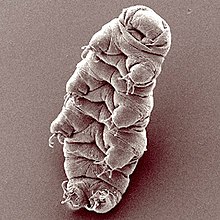| Hypsibius dujardini | |
|---|---|

| |
| Scientific classification | |
| Domain: | Eukaryota |
| Kingdom: | Animalia |
| Phylum: | Tardigrada |
| Class: | Eutardigrada |
| Order: | Parachela |
| Family: | Hypsibiidae |
| Genus: | Hypsibius |
| Species: | H. dujardini |
| Binomial name | |
| Hypsibius dujardini (Doyère, 1840) | |
| Synonyms | |
| |
Hypsibius dujardini sensu lato is a species complex of tardigrade in the class Eutardigrada. A member of this complex, Hypsibius exemplaris, is widely used for various research projects pertaining to evolutionary biology and astrobiology. The species was described by Louis Michel François Doyère in 1840 (as Macrobiotus dujardini).
H. exemplaris was differentiated from H. dujardini sensu stricto in 2018. Earlier studies refer to this lab species from northwest England as H. dujardini. H. dujardini s.s. is found in France, and has differences in 18S rRNA sequence and morphological details.
Habitat
The species, Hypsibius dujardini, is a tardigrade that prefers freshwater lakes, rivers, and streams. Because they are considered cosmopolitan, their geographical range is immense. They can be found in regions like the tropics and the poles.
Genome sequencing
The genome of Hypsibius exemplaris has been sequenced. Hypsibius exemplaris has a compact genome and a generation time of about two weeks. It can be cultured indefinitely and cryopreserved.
Protection of DNA
Hypsibius exemplaris contains an ortholog of the nuclear protein termed Dsup for damage suppression. Dsup binds to nucleosomes and protects chromatin DNA from hydroxyl radicals that could be generated by ionizing radiation or by hydrogen peroxide.
References
- ^ Gąsiorek, Piotr; Stec, Daniel; Morek, Witold; Michalczyk, Łukasz (2018). "An integrative redescription of Hypsibius dujardini (Doyère, 1840), the nominal taxon for Hypsibioidea (Tardigrada: Eutardigrada)". Zootaxa. 4415 (1): 45–75. doi:10.11646/zootaxa.4415.1.2. PMID 30313631.
- McFatter, M; Meyer, H; Hinton, J (2007). "Nearctic freshwater tardigrades: A review". Journal of Limnology. 66 (1): 84. CiteSeerX 10.1.1.851.3263. doi:10.4081/jlimnol.2007.s1.84.
- Koutsovoulos, Georgios; Kumar, Sujai; Laetsch, Dominik R.; Stevens, Lewis; Daub, Jennifer; Conlon, Claire; Maroon, Habib; Thomas, Fran; Aboobaker, Aziz A.; Blaxter, Mark (2016). "No evidence for extensive horizontal gene transfer in the genome of the tardigrade Hypsibius dujardini". Proceedings of the National Academy of Sciences of the United States of America. 113 (18): 5053–5058. Bibcode:2016PNAS..113.5053K. doi:10.1073/pnas.1600338113. ISSN 0027-8424. PMC 4983863. PMID 27035985.
- Yoshida, Yuki; Koutsovoulos, Georgios; Laetsch, Dominik R.; Stevens, Lewis; Kumar, Sujai; Horikawa, Daiki D.; Ishino, Kyoko; Komine, Shiori; Kunieda, Takekazu; Tomita, Masaru; Blaxter, Mark; Arakawa, Kazuharu; Tyler-Smith, Chris (27 July 2017). "Comparative genomics of the tardigrades Hypsibius dujardini and Ramazzottius varieornatus". PLOS Biology. 15 (7): e2002266. doi:10.1371/journal.pbio.2002266. PMC 5531438. PMID 28749982.
- Gabriel, W; et al. (2007). "The tardigrade Hypsibius dujardini, a new model for studying the evolution of development". Developmental Biology. 312 (2): 545–559. doi:10.1016/j.ydbio.2007.09.055. PMID 17996863.
- ^ Chavez C, Cruz-Becerra G, Fei J, Kassavetis GA, Kadonaga JT (October 2019). "The tardigrade damage suppressor protein binds to nucleosomes and protects DNA from hydroxyl radicals". eLife. 8: e47682. doi:10.7554/eLife.47682. PMC 6773438. PMID 31571581.
External links
- Tardigrada Newsletter
- Tardigrades - Pictures and Movies
- The Edinburgh Tardigrade project
- Tardigrades (English/German)
- Hypsibius dujardini and the evolution of development